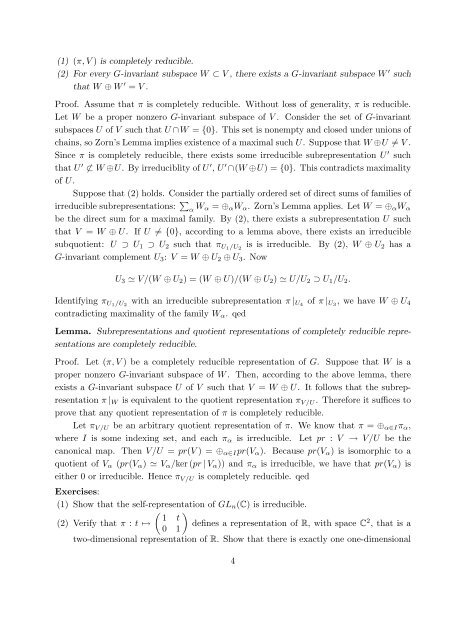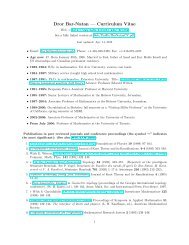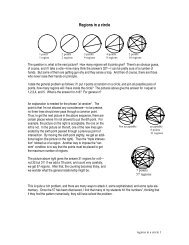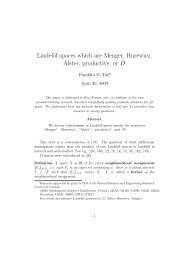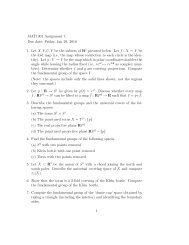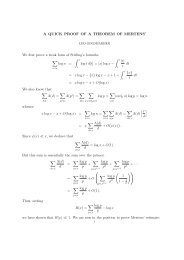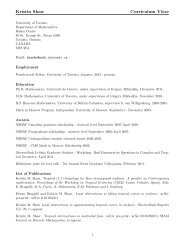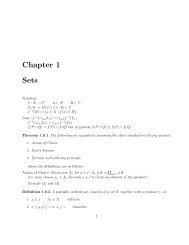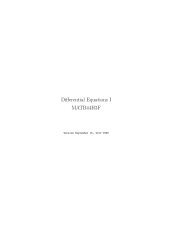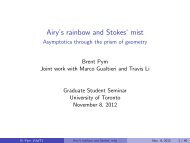MAT 445/1196 - INTRODUCTION TO REPRESENTATION THEORY ...
MAT 445/1196 - INTRODUCTION TO REPRESENTATION THEORY ...
MAT 445/1196 - INTRODUCTION TO REPRESENTATION THEORY ...
Create successful ePaper yourself
Turn your PDF publications into a flip-book with our unique Google optimized e-Paper software.
(1) (π, V ) is completely reducible.<br />
(2) For every G-invariant subspace W ⊂ V , there exists a G-invariant subspace W ′ such<br />
that W ⊕ W ′ = V .<br />
Proof. Assume that π is completely reducible. Without loss of generality, π is reducible.<br />
Let W be a proper nonzero G-invariant subspace of V . Consider the set of G-invariant<br />
subspaces U of V such that U ∩W = {0}. This set is nonempty and closed under unions of<br />
chains, so Zorn’s Lemma implies existence of a maximal such U. Suppose that W ⊕U = V .<br />
Since π is completely reducible, there exists some irreducible subrepresentation U ′ such<br />
that U ′ ⊂ W ⊕U. By irreduciblity of U ′ , U ′ ∩(W ⊕U) = {0}. This contradicts maximality<br />
of U.<br />
Suppose that (2) holds. Consider the partially ordered set of direct sums of families of<br />
irreducible subrepresentations: <br />
α Wα = ⊕αWα. Zorn’s Lemma applies. Let W = ⊕αWα<br />
be the direct sum for a maximal family. By (2), there exists a subrepresentation U such<br />
that V = W ⊕ U. If U = {0}, according to a lemma above, there exists an irreducible<br />
subquotient: U ⊃ U1 ⊃ U2 such that π U1/U2 is is irreducible. By (2), W ⊕ U2 has a<br />
G-invariant complement U3: V = W ⊕ U2 ⊕ U3. Now<br />
U3 V/(W ⊕ U2) = (W ⊕ U)/(W ⊕ U2) U/U2 ⊃ U1/U2.<br />
Identifying πU1/U2 with an irreducible subrepresentation π |U4 of π |U3 , we have W ⊕ U4<br />
contradicting maximality of the family Wα. qed<br />
Lemma. Subrepresentations and quotient representations of completely reducible representations<br />
are completely reducible.<br />
Proof. Let (π, V ) be a completely reducible representation of G. Suppose that W is a<br />
proper nonzero G-invariant subspace of W . Then, according to the above lemma, there<br />
exists a G-invariant subspace U of V such that V = W ⊕ U. It follows that the subrepresentation<br />
π |W is equivalent to the quotient representation π V/U . Therefore it suffices to<br />
prove that any quotient representation of π is completely reducible.<br />
Let π V/U be an arbitrary quotient representation of π. We know that π = ⊕α∈Iπα,<br />
where I is some indexing set, and each πα is irreducible. Let pr : V → V/U be the<br />
canonical map. Then V/U = pr(V ) = ⊕α∈Ipr(Vα). Because pr(Vα) is isomorphic to a<br />
quotient of Vα (pr(Vα) Vα/ker (pr | Vα)) and πα is irreducible, we have that pr(Vα) is<br />
either 0 or irreducible. Hence π V/U is completely reducible. qed<br />
Exercises:<br />
(1) Show that the self-representation of GLn(C) is irreducible.<br />
<br />
1 t<br />
(2) Verify that π : t ↦→ defines a representation of R, with space C<br />
0 1<br />
2 , that is a<br />
two-dimensional representation of R. Show that there is exactly one one-dimensional<br />
4


